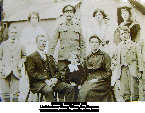
|
| HOME PAGE |
| MEMORIAL CROSS |
| HISTORY of the CROSS |
| ROLL of HONOUR |
| LINKS |
 Benjamin Berry Able Seaman J46454 Benjamin Berry was born on 6th April 1896, the son of Benjamin Berry a Hollocombe thatcher who had married Ellen Cockram about five years before. Benjamin was the younger brother of William Berry, who is listed on the Winkleigh Memorial Cross and whose history can be a accessed by clicking HERE. The family eventually comprised eight children with Joseph, the last one, being born in 1912. Benjamin did not join the forces immediately when war broke out, as did his brother William. Instead he became a ploughman, but later signed on, it is said without telling his parents, in 1916. He started his six months of Ordinary Seaman’s training at Devonport on 31st January 1916 when he was described as being 5ft 7in tall with dark brown hair, hazel eyes and a fresh complexion. After his training he was assigned to HMS Lupin on 27th of June 1916.
HMS Lupin was built by William Simons & Co Renfrew and launched 31 May 1916 and was one of the Arabis Class which was the third class of minesweeping sloops to be built under the Emergency War Programme for the Royal Navy in World War I as part of the larger “Flower Class”, which were also referred to as the “Cabbage Class”, or “Herbaceous Borders”. All thirty-six vessels to this design for the Royal Navy were ordered in July 1915, in three batches averaging twelve ships each; a further eight vessels were later built in British shipyards for the French Navy. They were single-screw Fleet Sweeping Vessels (Sloops) with triple hulls at the bows to give extra protection against loss when working. The Lupin was 268 feet long and had 2 x 4 inch guns, 2 x 3 pounders and a top speed of 17 knots. At another time she is recorded as having one 4 inch gun and five 2 pounder pom-poms. The Sloops were used exclusively for Mine sweeping until 1917 when they were reassigned for Convoy duties as well. From November 1918 she was with 2nd Minsweeper Flotilla, Grand Fleet. However, when Benjamin joined her, she was with the mine sweeping flotilla around Scotland and exploded nine mines on the 1st July. On 7th July, the flotilla was joined by three gun boats including HMS Skipjack to continue mine sweeping from Scapa Fow to Loch Eriball. The Lupin destroyed two foating mines and eight moored mines were brought up and destroyed. In the afternoon, Lupin left the foltilla to send a landing party to render a German naval mine safe. The next day the Lupin parted company with the flotilla together with HMS Skipjack. They found the SS Lisa of Bergansborg which had been abandoned by its crew and passengers. They had feared that the Lisa would sink after being mined. However, the Lisa did not sink and was now taken in tow for safe keeping to await the receiver of wrecks as the Lupin and Skipjack claimed salvage. Salvage money was awarded nine months later to both vessels which must have been a pleasnt surprise for Benjamin during his second week at sea. The Lupin went back to Scapa Flow the next day to continue her normal duties. As can be seen by the activities of the few previous days, although they were not in the front line of the few sea battles of the war, life on a mine sweeper was closer to the war and continually more active and in potentially dangerous circumstances than much of the fleet.
After the war, the Lupin initially was based at Invergordon. Later she served in mainly in the Middle East with occasional visits to India, presumably as part of the British gunboat diplomacy policy. In 1936 she was reduced to reserve and used as training accommodation, but eventually was used for target practice and scrapped in 1946. When Benjamin came back from the war he stayed in Winkleigh and married Hilda Mary Underhill in 1924. When the second World War broke out he joined the Winkleigh Home Guard. 20 June 2012 |
|---|
| [Top] | Back to Roll of Honour |

Click on an image for a larger picture |
 HMS Lupin
HMS Lupin After 18 months on the Lupin, Benjamin went back to Dartmouth for a further six months of training to become an Able Seaman, and returned to the Lupin on 12 June 1917 for the rest of the war. He was sent ashore on 8 May 1919 to be demobbed when he received his War Gratuity. He also received the Victory and British War medals.
After 18 months on the Lupin, Benjamin went back to Dartmouth for a further six months of training to become an Able Seaman, and returned to the Lupin on 12 June 1917 for the rest of the war. He was sent ashore on 8 May 1919 to be demobbed when he received his War Gratuity. He also received the Victory and British War medals.




